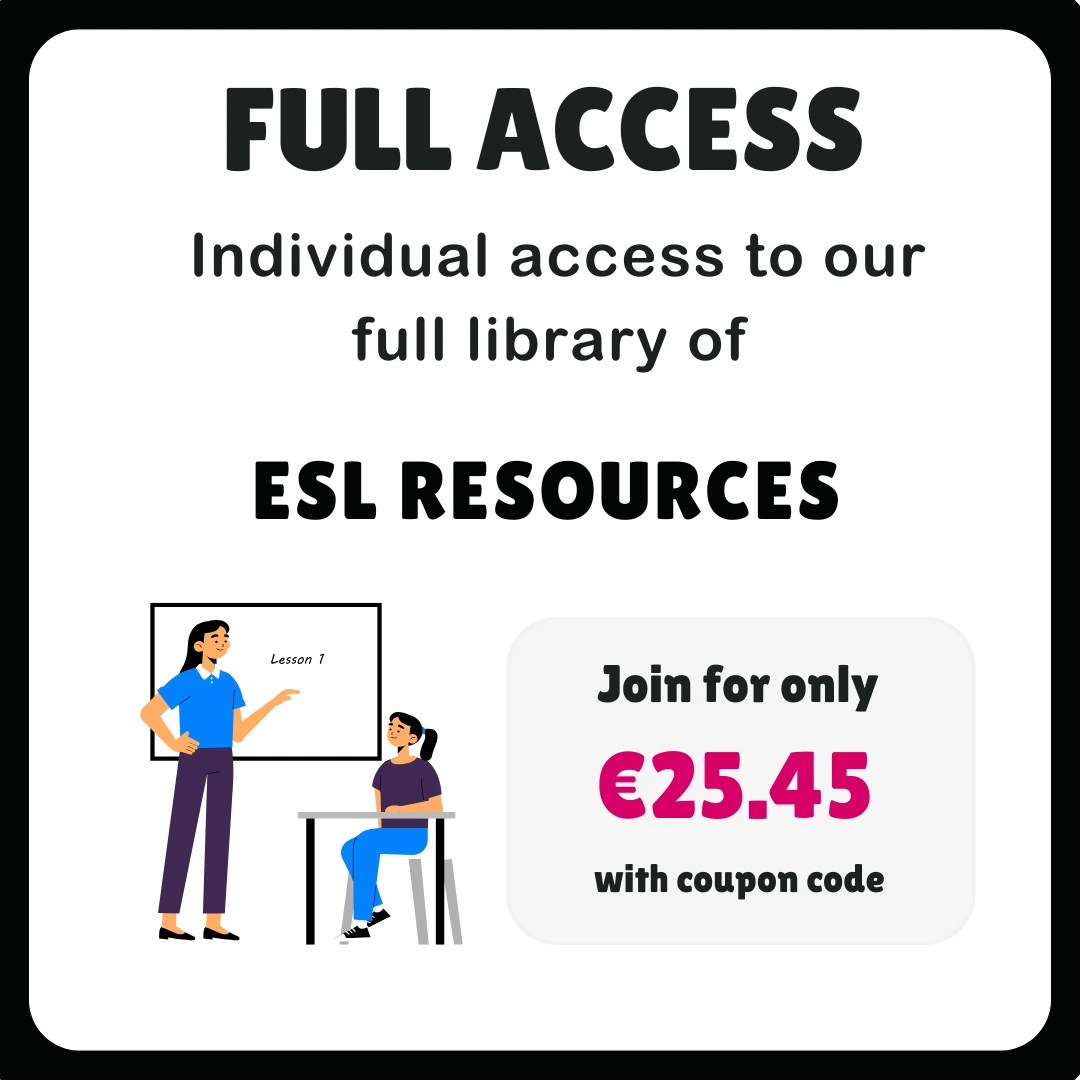September always feels like a fresh start — new groups, new energy, and new opportunities for learning. But the first lessons of the year are about more than opening the course book. They’re about breaking the ice, revising old language, setting routines, and motivating learners for the term ahead.
Here are some Back to School ESL Activities and first-day icebreakers for teens and adults. These classroom-tested resources (including free ESL activities) will save prep time and make the first week more engaging.
1. Back to School ESL Activities for Reflection and Goal-Setting
After the summer break, many learners are out of practice. If we dive straight into new grammar, important areas from last year can be overlooked or turn into fossilised errors. Beginning the term with reflection helps students assess their strengths and weaknesses, identify gaps in their learning, and plan strategies to make up for them. This sets the stage for more focused, confident progress in the months ahead.
✨ Teacher Tip:
Encourage students to review what they learned last year and rate their confidence. Ask questions like: Which grammar points do you remember clearly? Which ones still confuse you? Then, show them how to set goals that are specific and realistic. For example:
- “I will practise irregular verbs for 10 minutes every evening.” (clear and manageable)
vs. - “I will improve my grammar.” (too vague).
Finally, guide students to think about when and where they will study. For many teens and adults, it’s easier to build short study habits into their daily routine (e.g. reviewing on the bus, listening to a podcast while cooking, or setting aside 20 minutes before bed).
🔗 Resources:
- English Study Planner PDF & Progress Chart (A1–A2)
A structured reflection and goal-setting worksheet to help learners review A1 grammar, vocabulary, and skills before moving confidently into A2. – More levels coming soon! - Weekly English Study Plan (All Levels)
A simple printable & fillable planner that works for any CEFR level — learners set daily/weekly goals and reflect on their progress.
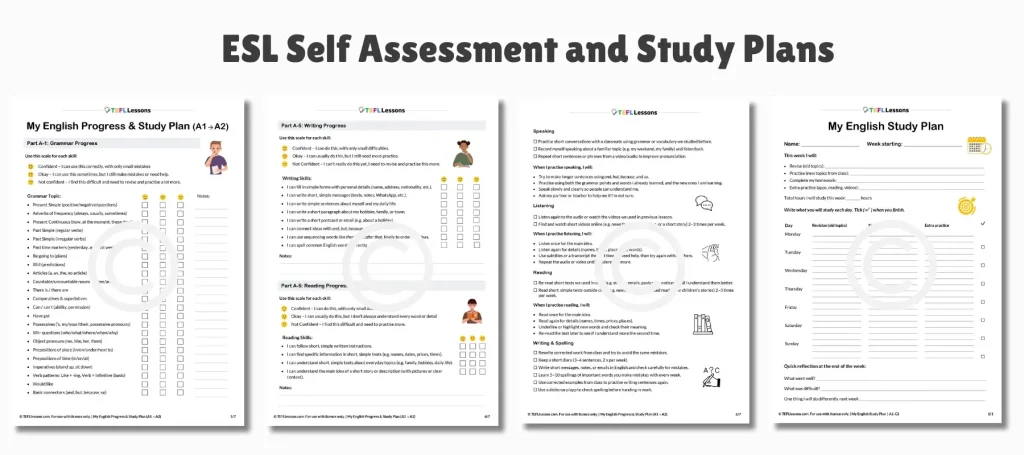
2. Getting to Know Your Class:
Fun Back to School ESL Activities for the First Week!
The first week is also about building a classroom community. Teens and adults may feel nervous speaking in front of new classmates, so ESL first day activities and ESL icebreakers are essential. If learners feel safe and supported early on, they’ll be more willing to take risks in English throughout the term.
✨ Teacher Tip:
Start with short, low-pressure tasks … These getting-to-know-you activities are especially useful as ESL first day activities
for adults and teens. They give every student a chance to speak without too much stress. Provide clear prompts or question cards so they aren’t left searching for words. One simple way to do this is with our Get to Know You Conversation Questions — available from A1 through C1. The A1 (Elementary) version is free. Use a mix of pair and group activities so students interact with more than one classmate. At the end, bring the group together for quick feedback — for example, ask students to introduce their partner to the class. This not only encourages speaking, but also active listening.
🔗 Useful activities:
- Get to Know You Conversation Questions (A1–C1)
A series of level-based conversation question sets (A1–C1) designed to get students talking. Ideal for pairwork or small groups at the start of term. - Language for Getting to Know Someone (A2–B1, FREE)
Dialogues and functional language practice for making introductions, asking questions, and starting conversations. - All about You Questions (A0–A1+)
A first-day speaking activity that helps learners practise introductions and small talk in English. - Free ESL Presentation Activity (B1–C2, FREE)
A flexible speaking task where students prepare a mini-presentation — great for building confidence early in the term. We also have a version for lower levels. - Informal Presentations: My Country (B1–B2)
A cultural speaking activity where learners share information about their home country, encouraging personal connection and listening skills.
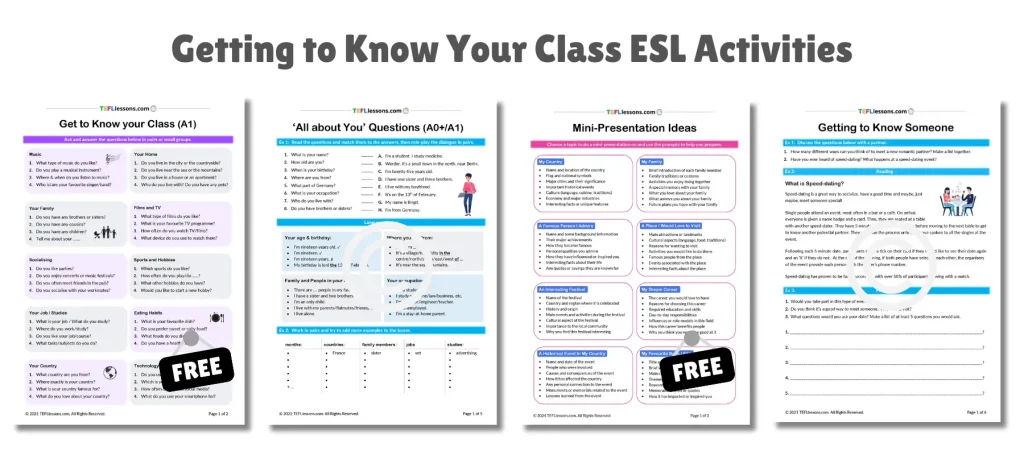
3. Talking About Holidays
One of the easiest ways to start September is to ask about the summer. Most learners have something to say — whether they travelled, worked, or simply relaxed. It’s also a natural chance to recycle past tenses and holiday vocabulary through communicative ESL activities like interviews or ESL conversation starters.
✨ Teacher Tip:
Instead of just asking students to tell the class about their summer, make it interactive. Use pair interviews so everyone gets speaking time. Encourage fluency first: let them talk naturally without too much correction. Then note a few useful errors on the board to review together. This keeps the activity communicative while still reinforcing accuracy, making it a natural choice for a fun ESL back to school activity.
🔗 Resources:
- Your Last Holiday – Holidays Vocabulary & Past Simple (A2)
A complete lesson with holiday vocabulary, guided speaking practice, and a short writing task about past experiences. This works perfectly as a Back to School ESL activity for reviewing holiday vocabulary and practising the past simple. - Talk for a Minute: Travel
This Talk for a Minute: Travel task is a great way to revise vocabulary connected to travel and holidays, develop fluency, and bring some fun into the classroom. - Holiday & Travel Phrasal Verbs (B2)
Students learn and practise useful phrasal verbs for travel, such as set off, check in, and pick up, through interactive tasks.
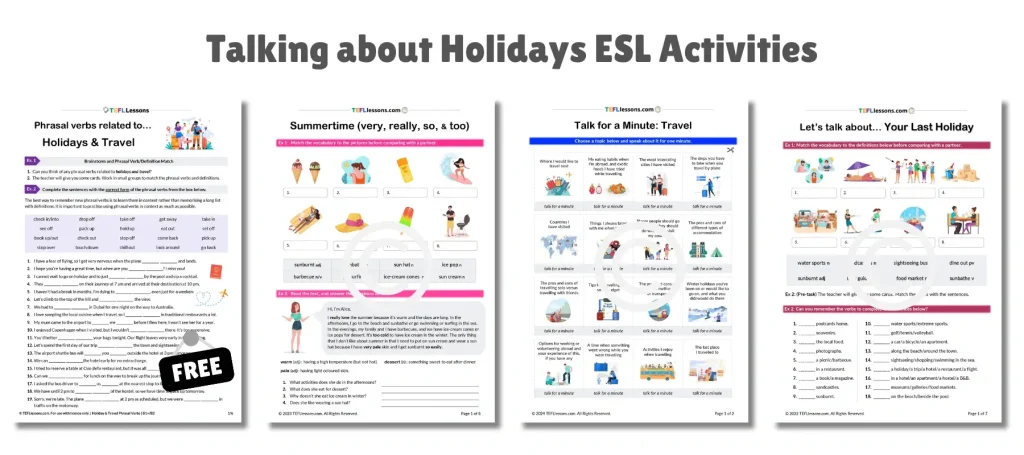
4. Beginner-Friendly Vocabulary for the First Weeks
If you’re starting with A0–A1 groups, the first lessons are about giving learners the tools to survive in class and talk about daily life. Students feel much more confident when they can name everyday objects and use simple verbs.
✨ Teacher Tip:
Introduce vocabulary in small chunks and recycle it often. For example, teach 5–10 new verbs per lesson and practise them in short dialogues. Use classroom objects around you (pen, board, chair) as immediate visual aids. Give students time to copy, repeat, and use new words in context so they stick. These are great beginner ESL activities, and you can make them even more engaging with these printable ESL worksheets.
🔗 Resources:
- Essential Nouns for Beginners (A0–A1)
- A starter pack of common nouns (household objects, everyday items) with visuals and practice activities.
- Essential Verbs for Beginners 1, 2 & 3 (A0–A1)
- Step-by-step verb packs covering the most frequent actions, with worksheets and speaking practice.
- Wild Animals Vocabulary (A0–A1)
- Introduces animal vocabulary through visuals, matching tasks, and speaking practice — perfect for beginner learners.
- Essential Nouns – English Class (A0–A1)
- Vocabulary and practice activities for key classroom items, helping learners build confidence in a school setting.
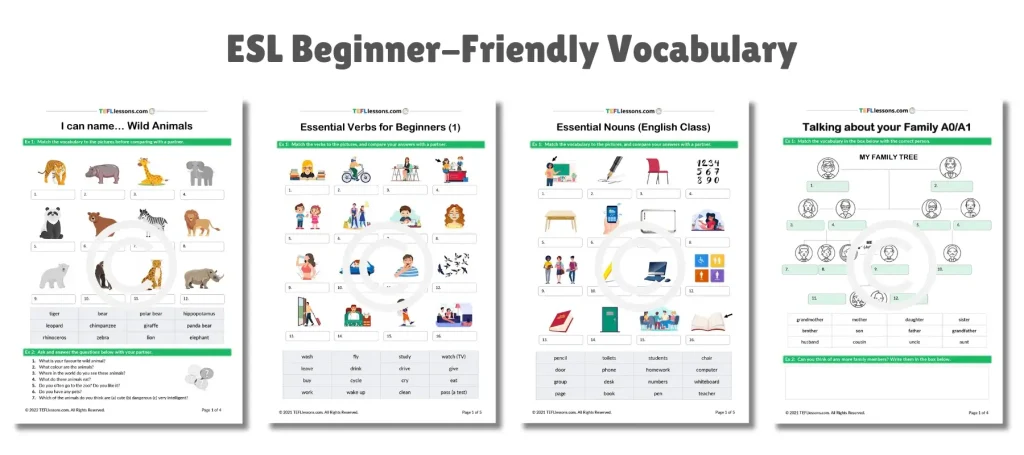
5. Posters and Start-of-Term Handouts
Back-to-school is also the time to set up classroom study aids that will support learning all year. Posters, charts, and records give learners a sense of independence and create visual reminders they can return to whenever they’re stuck.
✨ Teacher Tip:
Don’t just hand out posters — train students to actually use them. For example, keep a laminated phonemic chart at the front of the class and refer to it during pronunciation practice. Set up a vocabulary box in week one and add to it every lesson. Encourage students to record new words in their personal vocabulary record, not just rely on memory.
🔗 Resources:
- The Phonetic Chart (All Levels)
A classroom reference for teaching and practising English sounds, improving pronunciation awareness. - Vocabulary Record (FREE, All Levels)
A printable template for students to log and review their own vocabulary throughout the year. - Tenses Chart (FREE, All Levels)
A clear overview of English verb tenses — useful for quick reference during grammar lessons. - 50 Common Irregular Verbs (A1–A2)
A reference and practice pack for the most important irregular verbs, with exercises to reinforce form and meaning. - Vocabulary Box Game (A2–B2)
A classroom game for reviewing and recycling vocabulary. Students add new words each week and practise them regularly.
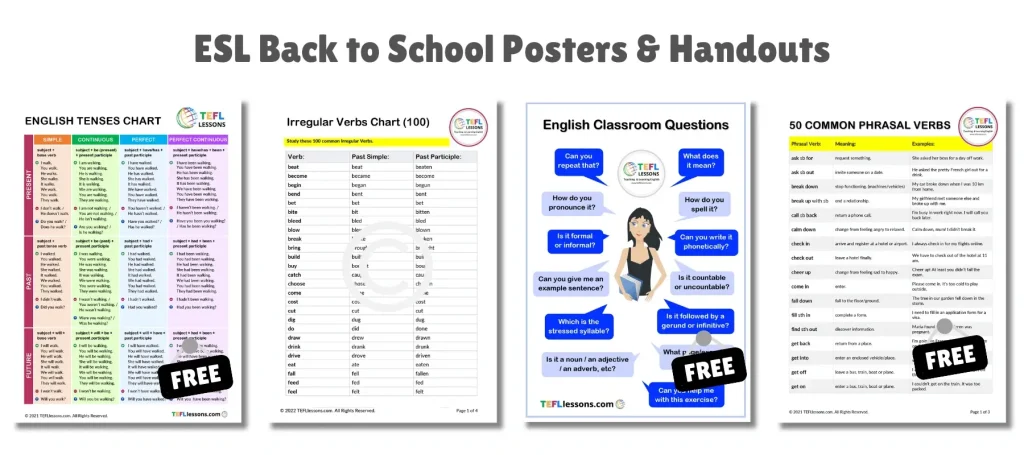
6. Grammar Review Lessons
The first week is also a good moment to revise grammar from the previous term with back to school ESL review activities. Learners often come back at very different levels of readiness, and review activities help to bring the class back in sync. Games are particularly effective because they combine revision with fun.
✨ Teacher Tip:
Focus on speaking and fluency during review activities. Let students play and interact, then use feedback time to highlight errors or remind them of key rules. This way, the review doesn’t feel like a test but still reinforces accuracy.
🔗 Activities to try:
- B1 Grammar Review Game (B1)
A snakes-and-ladders style board game reviewing key B1 grammar structures, an ideal back to school ESL activity for small groups. - A2 Grammar Game (A2)
An interactive board game to practise and consolidate essential A2 grammar points in a fun way. - Mixed Tenses Speaking Task (B1)
A speaking worksheet where learners use multiple tenses in context, encouraging accuracy and fluency. - ESL Error Correction Game (B1–B2)
A competitive classroom game where students identify and correct common grammar mistakes.
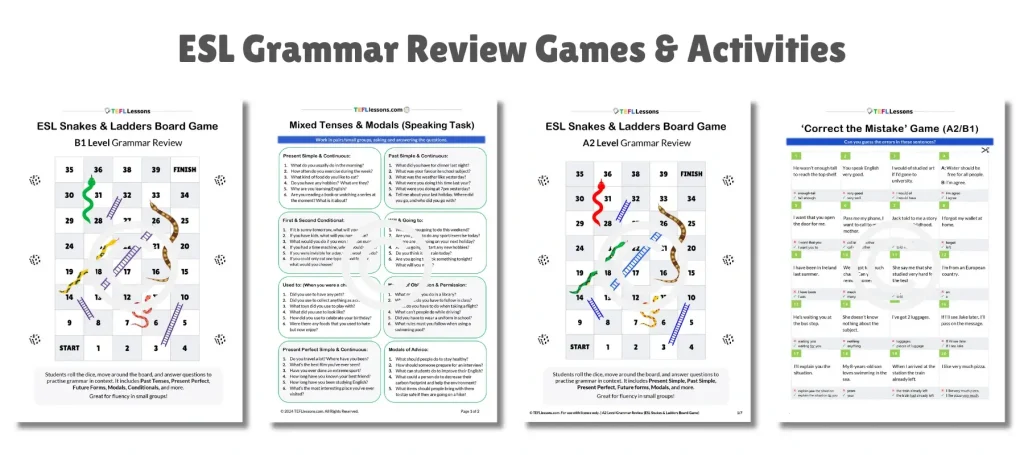
7. Vocabulary Revision & Fluency Games
Once students are comfortable again, keep the momentum going with fluency games. These short, high-energy tasks encourage quick recall and are perfect for warmers or end-of-lesson activities.
✨ Teacher Tip:
Fluency games work best when they’re repeated regularly but not overused. Rotate games (e.g. Taboo one week, Talk-for-a-Minute the next) to keep things fresh. Play in teams to lower pressure and boost motivation. These quick-fire games are some of the most popular ESL fun speaking activities — great for energy boosts at the end of class.
🔗 Resources:
- Taboo Vocabulary Game (C1-C2)
- A challenging fluency game where students explain words, building advanced paraphrasing skills and quick thinking. (Also available for A1–A2, B1, and B2 levels.)
- Name Five Vocabulary Game
- A fast-paced game where students try to name five things in a category — great for quick thinking and vocabulary review.
- ESL Guessing Game
- A lively speaking game that encourages learners to describe and guess words, boosting fluency and teamwork.
- Talk-for-a-Minute – Topics (B1–C1)
- A speaking fluency activity where students talk non-stop for one minute on a topic, developing confidence and quick thinking.
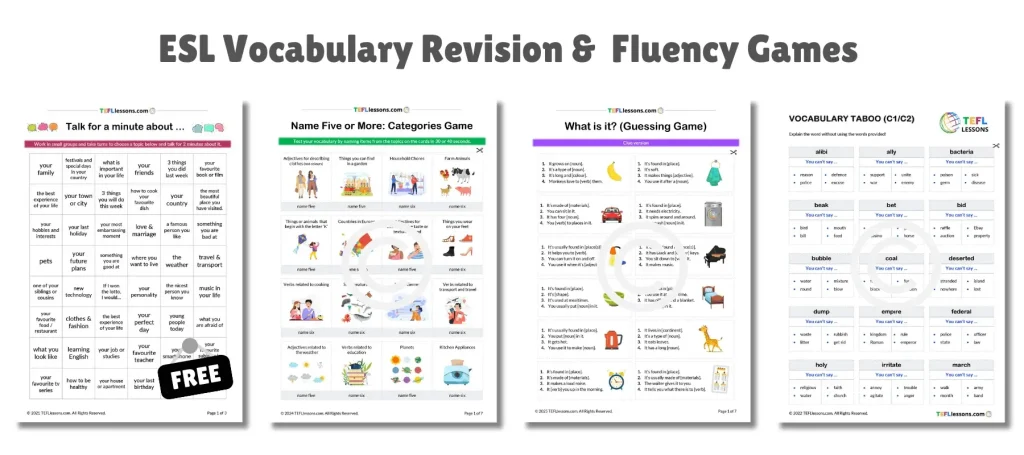
Wrapping Up
Effective back to school esl activities can set the tone for the entire year.
The first weeks of term are about much more than starting Unit 1. By combining:
- Reflection & goal-setting,
- Icebreakers,
- Holiday discussions,
- Beginner-friendly vocabulary,
- Classroom posters,
- Review lessons, and
- Fluency games,
…you can set up your learners for success all year.
Try some of these Back to School ESL Activities in class today!
Don’t forget to share your favourite back to school esl activities with us in the comments!
💡 More Free ESL Resources
We have over 100 free ESL resources available on TEFLlessons.com — from grammar worksheets to speaking games. You can also find many of these materials shared on our iSLCollective profile, making it easy to explore our work on different platforms.

